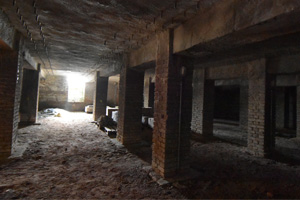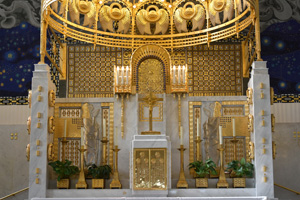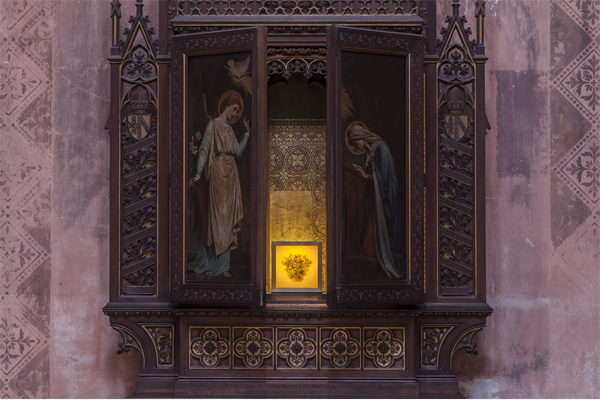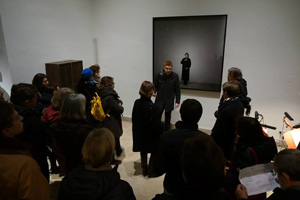MEMBERSHIP FORM
KUNSTGLAUBE BANK ACCOUNT
IBAN: AT88 3200 0000 0748 7481
BIC: RLNWATWW
KUNSTGLAUBE EXHIBITIONS
ART SINCE 1990
What we contemplate in contemporary art often reveals more about who we are, how we think and what brings us here than revealing an objective meaning present in the artwork. The space in which contemporary art is encountered has taken on a new significance since 1990 and repositioned the viewer as the subject in the experience of art.
RELIGIOUS EXPERIENCE
The artworks installed by KUNSTGLAUBE are not seen as religious where religion is the subject of art, but see art as the spirit or experience of religion. The experience of art is religious. Our exhibitions involve predominantly non-religious works appropriated and translated by the Church building.
SACRED SPACE
The encounter with contemporary art in ritual space insists on a dialogue firstly between the visitor and artwork, secondly between the artwork and the architecture, and thirdly between the architecture and the visitor. Ritual is the glue which draws the person, artwork and architecture into dialogue.
ABOUT KUNSTGLAUBE
KUNSTGLAUBE is an organisation which installs non-religious contemporary art in sacred spaces. Based in Vienna, Austria, this independent organisation seeks to offer people around the world the opportunity to experience the transforming power of art.
KUNSTGLAUBE exhibitions aim to engage visitors in a challenging and enriching experience involving:
ARTcontemporary art integrated into the architectural fabric of the Church building PLACE
religious perspective as it is expressed through ritual and architecture SELF
the complex tapestry of memories, mental associations and attitudes that make up the individual and shape one’s perspective.
This three-fold relationship between the artwork, viewer and space are essential to the location of meaning in the experience of contemporary art. The museum space supports a very different relationship with the art object and it should come as no surprise that the re-entry of art into non-museum spaces coincides with a shift in the way the body is positioned in contemporary art.
KUNSTGLAUBE's exhibitions involve a series of architecturally sensitive installations of contemporary art in the side chapels, confessionals and nave of the Church building. KUNSTGLAUBE seeks to open the church space to a critical dialogue between non-religious perspectives on what it means to be human and contemporary theology.
The works installed in churches both console and unsettle - aiming to disturb the comforted and comfort the disturbed. The Church space is traditionally reserved for contemplation and ritual action, providing refuge and consolation to people of all faiths and none. It must also be a challenging space that unsettles, provokes questions and gently exposes wounds and vulnerabilities. The art in KUNSTGLAUBE's exhibitions must sit on the thin and fraught line between consolation and disturbance - sensitively engaging with the architecture and the religious significance of the space.
WHY INSTALL CONTEMPORARY ART IN THE CHURCH?
One of the tasks of art is to remove us from the comfort of chatter (Das Gerede) and provocatively question commonly held values and widely accepted socio-cultural constructs. The transgressive rupture or erasure of these constructs in art can affect an awareness of our being in the world and deepen insight into who we are. In order to fulfil this function, art requires a particular reception that is often denied in the museum or gallery. The absence of ritual in the museum and distance between the viewer and artwork conspire against being confronted, disturbed or challenged by art.
The act of entering a church can be a stepping out of the world and into a space reserved for silence, involving the individual in an interaction with the architecture, art and quiet, where time slows down, the eyes having to adjust to the dim light, the lingering scent of incense filling the nostrils, inviting us to engage in gestures of submission and the result being deep consolation with attention drawn toward being present in the here and now. However, visiting a church isn’t always a consoling experience. A church can be foreboding, we can be distracted by elements that speak of the power structures of the religious institution. Symbols and images can seem irrelevant to our daily lived experience. And yet, there are moments when we might glimpse the potential of the space to speak directly to us in a very personal way. When we encounter contemporary art that speaks the language of our time, we are challenged to disregard this cynicism and discover that as much as these spaces are heavily bound to a specific religious tradition, they go deep into the human condition.
.jpg)






Christoph Bartylla-Print A4 360dpi.jpg)
Christoph Bartylla-Print A4 360dpi.jpg)
.jpg)
.jpg)